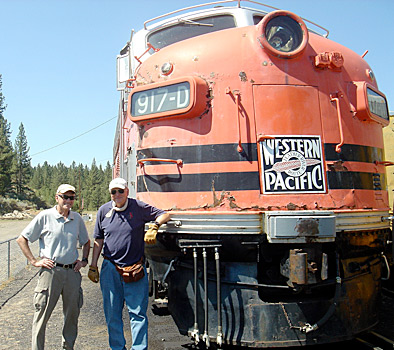
Authors George and Ted Blishak
TED SAYS: As a kid I wanted to grow up to be a locomotive engineer. As an adult I did become an engineer -- the Silicon Valley electronic kind – but sometimes still felt the urge to occupy the right hand seat of a streamlined diesel locomotive, my gloved left hand easing the throttle gradually to Run 8 (maximum power), my right hand easing off on the air brake valve, my sturdy work shoe holding down the dead man’s pedal.
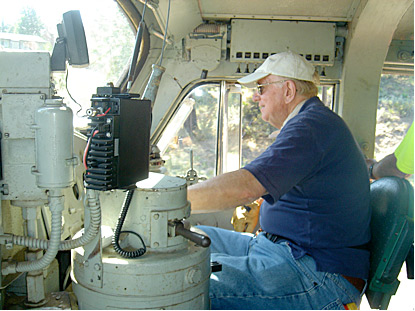
Ted Blishak at the controls of the GM F7A.
It isn't too late. One can still fulfill this dream!
Many tourist railroads and rail museums offer Engineer for a Day programs, giving railfans the opportunity to experience the thrill of sitting in the engineer's seat.
The Western Pacific Railroad Museum at Portola, California, rosters former Western Pacific Railroad locomotive #917-D, a General Motors Model F-7A Streamlined Freight Engine. Horsepower, 1500. Weight: 230,000 pounds (115 Tons).
I had owned a Lionel model of a Western Pacific F-3 engine, the precursor of the F-7. What would it be like to drive the real thing?
This engine is part of the museum's popular "Run a locomotive" program. $200 will permit you to rent this locomotive, by prior reservation, and operate it on the museum grounds under the close supervision of your own private instructor. Western Pacific F7 No. 913 at the Sacramento Railroad Museum.
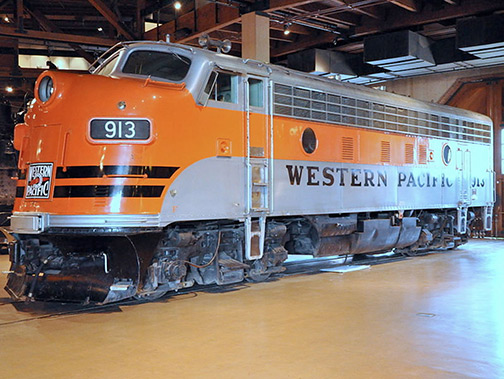
Western Pacific F7 No. 913 at the Sacramento Railroad Museum
You must be at least 18 years old and physically able to enter the locomotive cab via a steel ladder attached to the side (not as easy as it sounds) and operate the controls to participate.
Another option to drive a "grown-up's" version of an F-7A diesel exists at the Monticello Railway Museum in Monticello, Illinois. Guests may operate their 1953 Wabash Railroad F-7A #1189 every spring and fall for a donation through the "Throttle Time" program. For only $120.00 yyou get to spend 30 minutes observing, and learning how to, operate this locomotive, then 30 minutes running the locomotive under the supervision of a Museum Engineer. The equipment scheduled is always subject to change due to availability. While your first choice might be the streamlined Wabash F-7A, you may find yourself running Milwaukee Road NW-2 #1649 built in 1947, or Canadian National FPA-4 #6789 built in 1959.
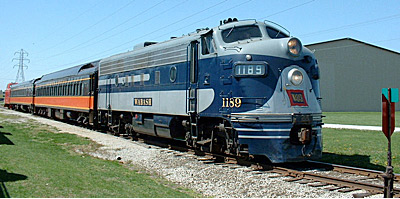
You can drive Wabash F-7A #1189 at the Monticello Railroad Museum in Illinois
You can drive Wabash F-7A #1189 at the Monticello Railroad Museum in Illinois you may find yourself running Milwaukee Road NW-2 #1649 built in 1947, or Canadian National FPA-4 #6789 built in 1959.
My brother George, visiting from Pennsylvania, was about to enjoy a significant birthday, and I thought “What a unique, unforgettable gift driving an engine could make.” When it's time for birthday gifts, we come close to the difficult category of "The Men Who Have Everything". But the gift of an experience can be priceless, and create great memories as well as an opportunity later for bragging rights. (For example, when it comes time to sit your grandson on your knee, is he going to be more impressed with your Rolex watch -- or your exciting tale of driving a real locomotive?)
I picked up the phone, called 1 530 832 4532, and signed George and myself up for the Run a Locomotive Rental program at the Western Pacific Museum, in the scenic Feather River Canyon, for July 19, 2013. George Blishak at the controls.
GEORGE SAYS: When Ted and I arrived at the railroad museum and I saw the Western Pacific F-7 diesel engine we would be driving, I immediately remembered the Lionel locomotive that Ted, as a youngster, purchased with his hard-earned savings from his newspaper route (and perhaps also his position as a Warner Brothers Theater usher).
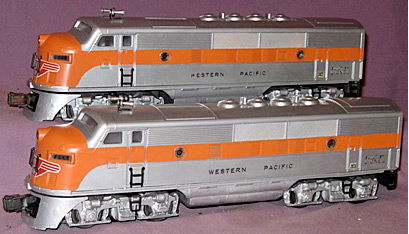
The 1952 Western Pacific F-3 model. Photo from the Lionel Trains Library on line.
The 1952 Western Pacific F-3 model. Photo from the Lionel Trains Library on line.
Here was its gigantic twin -- the same model, railroad and color scheme! There was a lot of excitement at our house in Ambridge, PA, the day Ted brought that model locomotive home. We began to run it on his recreation room train layout, providing the power for his stainless-steel colored, four car mini-California Zephyr.
Craig, the volunteer at the Western Pacific Railroad Museum was very pleasant, professional and thorough in his greeting to us, making us feel welcome. He clearly explained the basics of the engine controls that Ted and I would be using, then monitored our actions closely as we operated the engine.
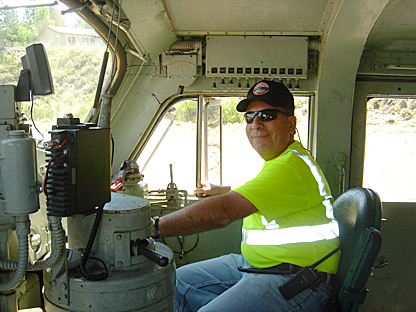
Craig, the Western Pacific Railroad Museum volunteer engineer.
Operating the engine exceeded my expectations. It was a memorable experience. The back and forth route through the museum rail yard and through a sparsely wooded area was not long, but it was certainly long enough to make for an interesting operation by the two student engineers. Fortunately, we did not have to learn all of the fairly complex controls of this sophisticated machine. For our short runs, it was only necessary to know the throttle, engine brake, reverse control, bell, headlight, and air horn.
And, yes, it was as enjoyable to operate the horn as Ted and I thought it would be. Our instructor was pleased and a bit surprised that we knew, and properly utilized, the dash-dash-dot-dash grade crossing horn signal. He mentioned that many of his students didn’t know it.
Our instructor made the session extra interesting by allowing us to test and grade ourselves on how accurately we could stop the locomotive at a couple of spots that he designated. We enjoyed the feeling of responsibility in operating this huge engine as well as we possibly could. We each made a couple of very minor errors in operating the controls. Perfectionists that Ted and I are, we got a little annoyed at ourselves for this, but they were minor errors indeed, not equipment or life threatening.
Now back to Ted, who explains about Run 8.
We were advised to ease the throttle back only as far as Run 2, since we were running light (that is, not pulling any cars). However, after feeling more confidant at the controls, I could no longer contain myself. I felt just like a kid again, and pulled back to Run 4 for a moment.
Wow! This is what it's all about! The 16 cylinder, 1500 HP, Model 567 diesel prime mover spooled up with its characteristic, hair-raising throaty rumble. But Craig admonished us coolly, “Hey, guys, back off to Run 2, OK?”
George and I both reverted back to adulthood when our feet hit the ground. We enjoyed the trip and learned a lot.
The next time a friend or neighbor starts to brag about his new Big Horn pickup truck with its Dodge Ram, 348 cubic inch, 395 hp Hemi V-8, we can upstage him by showing off the artfully framed Western Pacific Railroad Museum Locomotive Operation Certificate which proves that we have driven a much bigger vehicle than the one he owns.
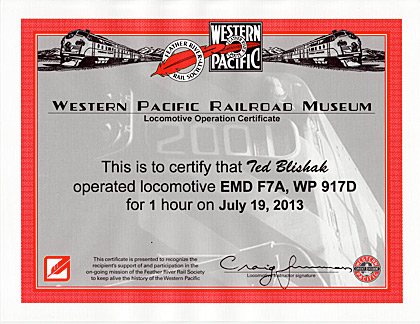
Western Pacific Railroad Museum locomotive operator's certificate
Of course, we will casually mention the specifications: General Motors Model 567, 9072 cubic inch, 1500 hp, V-16 diesel engine.
The Western Pacific Railroad Museum claims to be "Home of the Original 'Run A Locomotive' program." (The idea has caught on, and many rail museums and tourist railroads in North America offer opportunities to drive steam and diesel engines as well as street cars.)
The Western Pacific Railroad itself was absorbed into the Union Pacific Railroad system in 1982. The UP donated equipment to the Museum, which now has a collection of more than 30 locomotives and 100 cars. The Western Pacific Railroad Museum is located near the California/Nevada border, one hour northwest of Reno, at 700 Western Pacific Way, in the City of Portola, CA 96122. Visit www.wplives.org/ for more information or call 1 503 832 4131.
All Aboard!
|